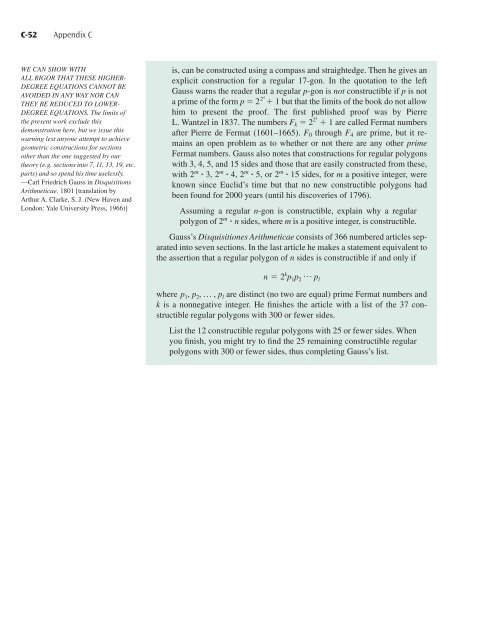You also want an ePaper? Increase the reach of your titles
YUMPU automatically turns print PDFs into web optimized ePapers that Google loves.
C-52 Appendix C<br />
WE CAN SHOW WITH<br />
ALL RIGOR THAT THESE HIGHER-<br />
DEGREE EQUATIONS CANNOT BE<br />
AVOIDED IN ANY WAY NOR CAN<br />
THEY BE REDUCED TO LOWER-<br />
DEGREE EQUATIONS. The limits of<br />
the present work exclude this<br />
demonstration here, but we issue this<br />
warning lest anyone attempt to achieve<br />
geometric constructions for sections<br />
other than the one suggested by our<br />
theory (e.g. sections into 7, 11, 13, 19, etc.<br />
parts) and so spend his time uselessly.<br />
—Carl Friedrich Gauss in Disquisitions<br />
Arithmeticae, 1801 [translation by<br />
Arthur A. Clarke, S. J. (New Haven and<br />
London: Yale University Press, 1966)]<br />
is, can be constructed using a compass and straightedge. Then he gives an<br />
explicit construction for a regular 17-gon. In the quotation to the left<br />
Gauss warns the reader that a regular p-gon is not constructible if p is not<br />
a prime of the form p 2 2k<br />
1 but that the limits of the book do not allow<br />
him to present the proof. The first published proof was by Pierre<br />
L. Wantzel in 1837. The numbers F k 2 2k<br />
1 are called Fermat numbers<br />
after Pierre de Fermat (1601–1665). F 0 through F 4 are prime, but it remains<br />
an open problem as to whether or not there are any other prime<br />
Fermat numbers. Gauss also notes that constructions for regular polygons<br />
with 3, 4, 5, and 15 sides and those that are easily constructed from these,<br />
with 2 m 3, 2 m 4, 2 m 5, or 2 m 15 sides, for m a positive integer, were<br />
known since Euclid’s time but that no new constructible polygons had<br />
been found for 2000 years (until his discoveries of 1796).<br />
Assuming a regular n-gon is constructible, explain why a regular<br />
polygon of 2 m n sides, where m is a positive integer, is constructible.<br />
Gauss’s Disquisitiones Arithmeticae consists of 366 numbered articles separated<br />
into seven sections. In the last article he makes a statement equivalent to<br />
the assertion that a regular polygon of n sides is constructible if and only if<br />
n 2 k p 1 p 2<br />
p pl<br />
where p 1 , p 2 , p , p l are distinct (no two are equal) prime Fermat numbers and<br />
k is a nonnegative integer. He finishes the article with a list of the 37 constructible<br />
regular polygons with 300 or fewer sides.<br />
List the 12 constructible regular polygons with 25 or fewer sides. When<br />
you finish, you might try to find the 25 remaining constructible regular<br />
polygons with 300 or fewer sides, thus completing Gauss’s list.
















